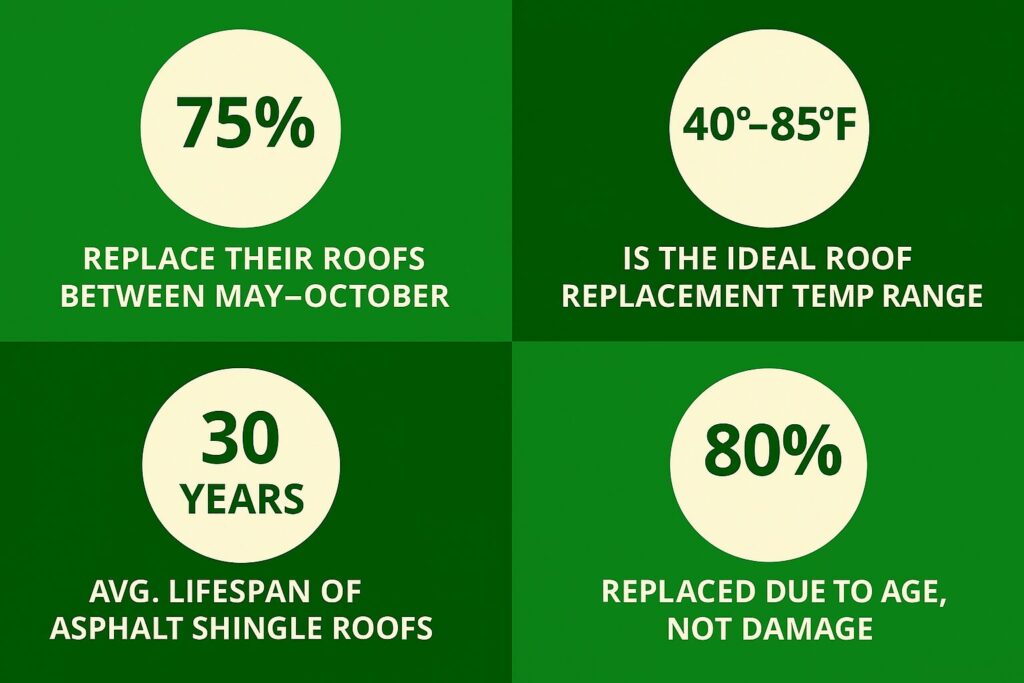Thinking of replacing your roof? Timing’s everything. Rush it, and you could overpay or settle for whoever’s available. Wait too long, and you might be dealing with leaks during a storm.
There’s a sweet spot—where weather, cost, and contractor availability actually line up. Fall’s the fan favorite, but every season has pros and cons.
We’ll break down when to replace your roof—without the guesswork.
Key Notes
- Fall offers ideal temperatures and contractor availability for nearly all roof types.
- Winter installations often come with cost savings but material limitations.
- Material choice determines which seasons are viable for your specific replacement.
Timing Matters: When Should You Replace Your Roof?
Replacing a roof isn’t something you do on a whim. It’s a major project that calls for the right timing, the right weather, and the right contractor availability.
Get it wrong, and you could end up with delays, higher costs, or poor installation. Get it right, and you’ll have a long-lasting, weatherproof roof that protects your home for decades.
So, what is the best time of year to replace roof shingles or metal panels? Here’s our expert take, season by season:
Spring: A Solid Choice, But Unpredictable
Spring offers mild temperatures that help asphalt shingles seal properly. It’s also a good time to fix winter damage before the summer heat kicks in.
Pros:
- Mild temperatures make installation easier
- Ideal conditions for asphalt and clay tiles
Cons:
- Frequent rain can cause delays
- High demand as homeowners rush to book contractors
Summer: Hot, Busy & Expensive
Summer is the peak roofing season. While longer daylight hours allow for faster work, extreme heat makes conditions tough for both workers and materials.
Pros:
- No rain delays, predictable weather
- Longer workdays mean faster completion
Cons:
- High temperatures can soften shingles, affecting installation
- Contractor availability is tight, and prices are higher
Fall: The Goldilocks Season
Fall is often considered the best time to get a new roof. Temperatures are stable, and contractors are still available before winter rushes in.
Replacing a roof in fall ensures the best installation conditions. Contractors aren’t fighting extreme heat or cold, and shingles adhere properly before winter hits.
Pros:
- Ideal temperatures for all roofing materials
- Contractors are still available if booked early
- No summer heat or winter storms to worry about
Cons:
- High demand—schedule early or miss out
Winter: Risky, But Possible
Winter roofing comes with challenges, but it’s not impossible. Metal roofs, in particular, can be installed year-round, and off-season discounts are common.
Pros:
- Lower prices and better contractor availability
- Good for metal roofing and emergency repairs
Cons:
- Cold weather can make asphalt shingles brittle
- Shorter daylight hours slow down work
What Affects the Best Time of Year to Replace a Roof?
Timing isn’t just about convenience. The season you choose impacts everything from installation quality to how much you pay.
Here’s what you need to consider:
|

How Roof Type Affects the Best Time for Replacement
Not all roofs react the same way to different weather conditions. The best season depends on the material you’re working with:
|
Regional Climate and Roof Replacement Timing
Where you live plays a huge role in when to replace your roof. A one-size-fits-all approach doesn’t work when climate varies so much across the US.
|
Frequently Asked Questions
When does roofing season start?
In most parts of the US, roofing season starts in late spring when temperatures consistently stay above 40°F. This is when contractors get busy.
What time of year is the cheapest to replace a roof?
Winter is typically the slow season for roofing, meaning you might get a discount if you can find a contractor willing to work in colder conditions.
Should I stay home during my roof replacement?
Staying home depends on your tolerance for noise. Roof replacement is loud and disruptive, but you don’t have to leave unless access to your home is restricted.
Conclusion
No matter the season, the “right” time to replace your roof is really about balance—between weather, budget, contractor availability, and what your roof actually needs.
Fall may be the favorite for a reason, but spring’s a strong contender, and even winter can work under the right conditions (especially with metal roofs). What most people don’t realize is that flexibility can save you money—if your roof’s not urgent, timing your project just right can get you better deals and a smoother experience.
If you’re wondering when your roof should be replaced—or if it even needs to be yet—reach out for a free quote. Whether it’s a quick repair or full replacement, we’ll help you weigh your options.

